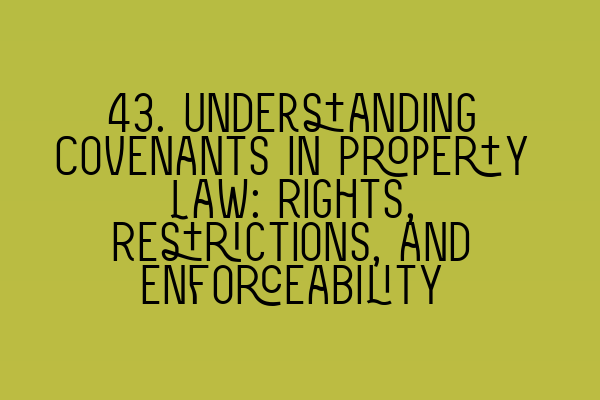Understanding Covenants in Property Law: Rights, Restrictions, and Enforceability
Welcome to the SQE Property Law & Land Law blog! In this comprehensive guide, we will delve into the intricacies of covenants in property law. Whether you’re a law student preparing for the SQE exams or a professional in the field, understanding covenants is crucial for success in property transactions. Let’s explore the rights, restrictions, and enforceability of covenants.
What are Covenants?
Covenants are legally binding agreements that impose obligations or restrictions on the use or enjoyment of a property. They are commonly found in property deeds, contracts, leases, and other legal documents. Covenants serve to protect the interests of both the grantor (the party imposing the covenant) and the grantee (the party bound by the covenant).
There are two types of covenants:
- Positive Covenants: Positive covenants require the grantee to perform certain actions, such as maintaining the property or paying fees.
- Restrictive Covenants: Restrictive covenants impose limitations on the grantee’s use or enjoyment of the property, such as prohibiting certain activities or modifications.
Now, let’s delve deeper into the rights, restrictions, and enforceability of covenants in property law.
Rights and Restrictions
Covenants can grant certain rights to the parties involved. For example, a positive covenant might grant the grantor the right to access the property for inspection or maintenance purposes. On the other hand, restrictive covenants restrict or limit the rights of the grantee.
Common examples of restrictive covenants include:
- Prohibiting the construction of additional structures without permission
- Restricting the use of the property to residential purposes only
- Prohibiting the keeping of certain animals on the property
- Requiring the grantee to maintain the property in a certain condition
These restrictions are often put in place to maintain the character and value of a property or to address concerns of neighboring properties.
Enforceability
For a covenant to be enforceable, certain conditions must be met:
- Intention to Bind: The covenanting parties must have the intention to create a legally binding agreement.
- Touch and Concern the Land: The covenant must relate to the use or enjoyment of the property involved.
- Privity of Estate: The covenant must have been made between the original parties who held a legal estate or interest in the property.
- Notice: The grantee must have had notice of the covenant at the time of acquiring the property or must be deemed to have constructive notice.
Enforceability can also depend on the type of covenant. Positive covenants are generally more difficult to enforce as they impose ongoing obligations on the grantee. However, through mechanisms such as rent charges or land charges, positive covenants can be given more weight and enforceability.
Conclusion
Covenants play a vital role in property law, protecting the interests of both grantors and grantees. Understanding the rights, restrictions, and enforceability of covenants is essential for all property law practitioners. We hope this guide has provided you with a comprehensive overview of covenants in property law.
If you’re studying for the SQE exams, make sure to check out our SQE 1 Practice Exam Questions and SQE 1 Practice Mocks FLK1 FLK2 for comprehensive preparation. Interested in SQE 2 preparation courses? We’ve got you covered! Discover our SQE 2 Preparation Courses to boost your knowledge and skills. And if you’re just getting started, don’t forget to explore our SQE 1 Preparation Courses to kickstart your journey.
Stay tuned for more informative articles on property law, land law, and everything related to the SQE exams. And remember, at SQE Property Law & Land Law, we’re here to guide you through every step of your legal journey.
